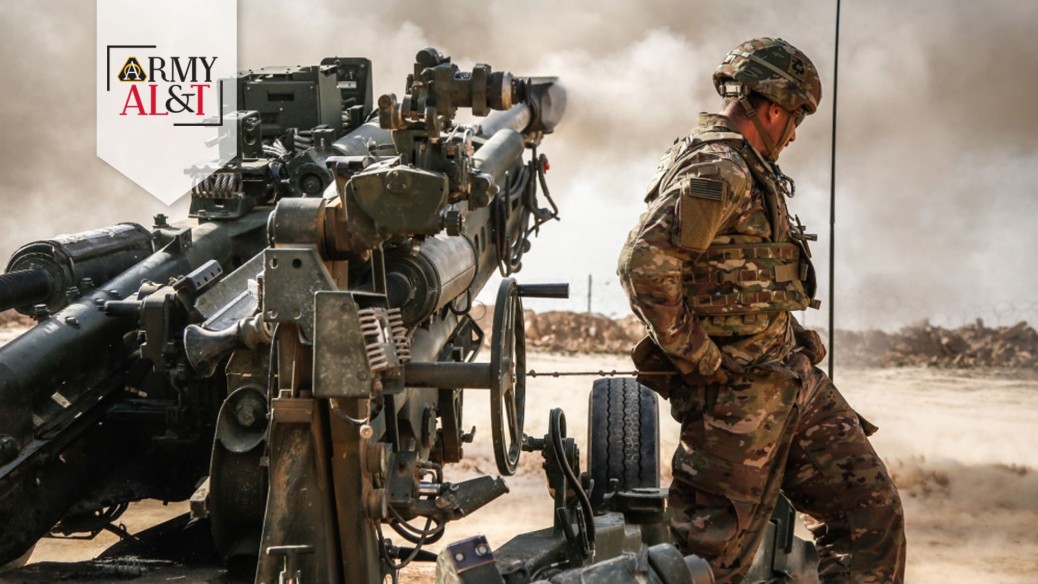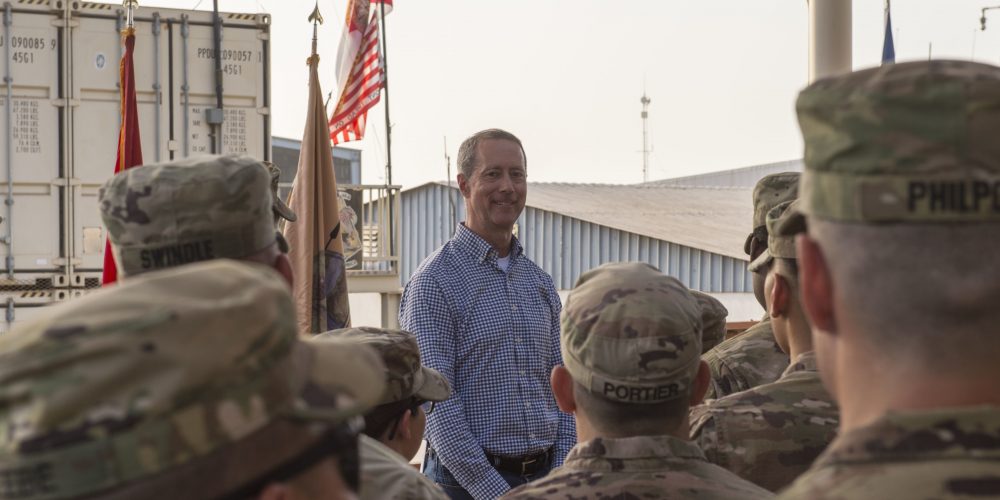How a demonstration of translating targeting data between the Army and the Air Force confirmed a prototype for long-range precision fires in multidomain operations.
by Maj. Isaac Lewellen, Chief Warrant Officer 3 James Patrick and Larry Jennings
All parties were on standby, eager to take the next step toward operationalizing a prototype capability in software translation and demonstrating its utility over active military networks.
As part of a two-week plan, the team conducted initial connectivity and quickly identified network and configuration issues. They immediately began to work through the hurdles, and after a few days of additional testing and development, addressed the technical issues. The team was ready to launch the exercise.
This time they were on familiar ground, initiating communications from the Air Force’s Common Mission Control Center (CMCC) at Beale Air Force Base in Yuba County, California, to the 101st Airborne Division Artillery at Fort Campbell, Kentucky.
The goal was to provide insights and help prove a critical new capability in software translation: converting, in real time and strictly from machine to machine, an Air Force Universal Command and Control Initiative message to the Army’s Variable Message Format. A message from one service’s message system had been converted to another service’s messaging format in a lab many times; this would be the first such conversion in an operational setting. It would show an initial sensor-to-shooter capability that could pass targeting data between services to the Army’s fire control system.
Here’s why this message conversion is necessary. Today, communicating between these Army and Air Force systems requires Soldiers and Airmen to monitor or scan a multitude of internet relay chat windows, or other communications, and then manually transfer and input data into their respective systems. This can lead to time delays and possible human errors. A conversion is required in order to allow these two systems to communicate machine-to-machine.
Unfortunately, this is not as simple as just converting messages on a one-for-one basis. In some cases it takes multiple messages from one format to create a single message in the converted format. When conversion is successful it allows the Army access to Air Force intelligence, surveillance and reconnaissance assets, and the Air Force access to Army fires units without having to go through layers of organizations, thereby speeding up the kill chain process and reducing the chance of targeting errors.
Back to the test meant to solve this problem: At the helm were the Army Rapid Capabilities and Critical Technologies Office (RCCTO), the Air Force Rapid Capabilities Office (RCO) and the 101st Airborne Division Artillery. To launch the demonstration, the Air Force RCO selected a critical target within an area of responsibility outside the range of Army sensors and initiated a call for fires from the Common Missile Control Center. This initial sensor message was downlinked to the control center and initiated the call for fires, which was seamlessly translated from the Air Force Command and Control Initiative standard to the Army Variable Message Format standard, and delivered to the 101st at Fort Campbell.
Despite the different systems it only took minutes to complete the machine-to-machine transfer. In doing so the services can begin to move from a linear, static and stove-piped “kill chain” to one where the kill chains overlap and all the domains of war are interconnected into one network to create a “kill web” with multiple paths. Using the machine-to-machine translation reduced the chance for human error, while significantly decreasing the time traditional dynamic targeting takes to execute. The process demonstrated the value of leveraging sensors that are not organic to the Army—such as Air Force sensors—while opening up the strike options for the Air Force. The adapter enabled more timely prosecution of critical targets in the conduct of multidomain operations.
INFORMATION AT THE NEEDED SPEED
In a complex fight in an anti-access and area denial environment, the time it takes to deliver information from sensor to shooter is critical. Recognizing the need to speed up long-range fires communication and execution among the services, the chiefs of staff of the Army and Air Force directed that an Army-Air Force summit be held. At the summit, in August 2018, the two services focused on applying and integrating their open-architecture technologies and approaches to boost speed, precision and agility on the battlefield. The sensor-to-shooter demo, executed on April 5, was one outcome of this summit.
The purpose of the sensor-to-shooter prototype was to demonstrate the technical feasibility of a machine-to-machine data flow for targeting that would allow Air Force sensors to direct Army fires. Although multiple processes and associated methods are available to execute cross-domain dynamic targeting, the RCCTO solution is unique in leveraging an existing Air Force sensor platform and applying limited software development to translate message formats in near-real time for consumption by Army firing platforms.
As an initial proof of concept, the prototype showed the integration power of Air Force intelligence, surveillance and reconnaissance systems in passing targeting data, machine to machine, to Army fires in an operational scenario. It leveraged modular open-systems approaches to sensor and weapon integration, in which information sharing in real time is key to neutralizing the threat.
Doing so leaves the door open for new, and ever-evolving, ways to sense and identify targets and establishes the ability to neutralize the target with a new or updated weapons package without having to re-implement the solution. Achieving rapid machine-to-machine information sharing requires common standards and well-defined system interfaces.
LESSONS LEARNED
In preparation for the live demonstration, the RCCTO partnered with the Systems Integration Lab of the U.S. Army Combat Capabilities Development Command’s C5ISR [Command, Control, Computers, Communications, Cyber, Intelligence, Surveillance and Reconnaissance] Center at Aberdeen Proving Ground, Maryland, to create a development environment. This consisted of computers hosting “virtual machines” of the Air Force CMCC software, the message translation software and the Army Advanced Field Artillery Tactical Data System application—that is, the sensor that would detect a target, the software that would translate the message generated by the sensor, and the artillery that would fire on the target. The early testing enabled proper translation and formatting of the critical message traffic.
Both the lab testing and the demonstration highlighted the need for more standard workflows for fires units when passing messages to joint forces, including observer mission updates. Additionally, capabilities for sharing situational awareness could be enhanced to streamline the air and ground fires clearance processes while minimizing the potential for friendly fire or fratricide.
Additional analysis will be necessary to move toward greater use of common standards. On a modern battlefield, with multiple units and multiple services, this becomes a much more complex idea that will require the application of advanced machine learning and artificial intelligence. One of the key assumptions behind the April demonstration vignette is that the sensor detects an unplanned target as a “Joint Force Commander Critical Target” as described in the multiservice tactics, techniques and procedures publication for dynamic targeting. These particular targets typically represent a very small portion of the total and in most cases require an immediate response because of the potential danger to friendly forces.
CONCLUSION
The sensor-to-shooter team successfully demonstrated the technical feasibility of machine–to-machine connectivity facilitating Air Force and Army bidirectional message passing. Next, the RCCTO team is planning to conduct a possible end-to-end test of the entire sensor-to-shooter kill chain. This expanded chain will yield additional lessons learned and insights into machine-to-machine execution and the time to completion of complex kill chains. Additional development could explore an early discussion on hosting the adapter software at an Army unit, creating a more direct link from an Air Force platform to an Army fires unit. Collaboration with United States Army Europe continues, with G-3 Fires and G-6 providing input and expertise for continued development of a direct link test and network connectivity for the current software.
Ultimately, the Army will need to conduct further exercises to evaluate message flows in disparate geographic locations to further operationalize the technology. One of many sensor-to-shooter efforts, this will be an important step in creating a better integrated and more lethal joint team to defeat anti-access and area denial measures.
For more information, go to the RCCTO website, https://rapidcapabilitiesoffice.army.mil/.
MAJ. (P) ISAAC LEWELLEN is the RCCTO Sensor to Shooter Joint Project lead. He is an air defense officer with Patriot and indirect fire protection capability battalion experience. He holds a B.S. in psychology from the University of Oregon.
CHIEF WARRANT OFFICER 3 JAMES PATRICK is a network management technician for the RCCTO Sensor to Shooter project. He is a signal warrant officer with experience in communications and acquisitions.
LARRY JENNINGS is the MITRE Corp. project lead across various RCCTO initiatives. He has specialized in advanced concepts development and agile acquisition over the last several years. He holds a M.S. in management information systems from Bowie State University and a B.S. in business administration from the University of Montana.
This article is published in the Summer 2019 issue of Army AL&T magazine.
















